Orthoptic (geometry)
In the geometry of curves, an orthoptic is the set of points for which two tangents of a given curve meet at a right angle.



Examples:
- The orthoptic of a parabola is its directrix (proof: see below),
- The orthoptic of an ellipse x2/a2 + y2/b2 = 1 is the director circle x2 + y2 = a2 + b2 (see below),
- The orthoptic of a hyperbola x2/a2 − y2/b2 = 1, a > b, is the circle x2 + y2 = a2 − b2 (in case of a ≤ b there are no orthogonal tangents, see below),
- The orthoptic of an astroid x2⁄3 + y2⁄3 = 1 is a quadrifolium with the polar equation
- (see below).
Generalizations:
- An isoptic is the set of points for which two tangents of a given curve meet at a fixed angle (see below).
- An isoptic of two plane curves is the set of points for which two tangents meet at a fixed angle.
- Thales' theorem on a chord PQ can be considered as the orthoptic of two circles which are degenerated to the two points P and Q.
Orthoptic of a parabola
Any parabola can be transformed by a rigid motion (angles are not changed) into a parabola with equation . The slope at a point of the parabola is . Replacing gives the parametric representation of the parabola with the tangent slope as parameter: The tangent has the equation with the still unknown , which can be determined by inserting the coordinates of the parabola point. One gets
If a tangent contains the point (x0, y0), off the parabola, then the equation
holds, which has two solutions m1 and m2 corresponding to the two tangents passing (x0, y0). The free term of a reduced quadratic equation is always the product of its solutions. Hence, if the tangents meet at (x0, y0) orthogonally, the following equations hold:
The last equation is equivalent to
which is the equation of the directrix.
Orthoptic of an ellipse and hyperbola
Ellipse
Let be the ellipse of consideration.
(1) The tangents of ellipse at neighbored vertices intersect at one of the 4 points , which lie on the desired orthoptic curve (circle ).
(2) The tangent at a point of the ellipse has the equation (s. Ellipse). If the point is not a vertex this equation can be solved:
Using the abbreviations and the equation one gets:
Hence and the equation of a non vertical tangent is
Solving relations for and respecting leads to the slope depending parametric representation of the ellipse:
- (For another proof: see Ellipse.)
If a tangent contains the point , off the ellipse, then the equation
holds. Eliminating the square root leads to
which has two solutions corresponding to the two tangents passing . The free term of a reduced quadratic equation is always the product of its solutions. Hence, if the tangents meet at orthogonally, the following equations hold:
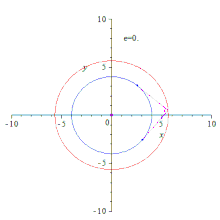
The last equation is equivalent to
From (1) and (2) one gets:
- The intersection points of orthogonal tangents are points of the circle .
Hyperbola
The ellipse case can be adopted nearly exactly to the hyperbola case. The only changes to be made are to replace with and to restrict m to |m| > b/a. Therefore:
- The intersection points of orthogonal tangents are points of the circle , where a > b.
Orthoptic of an astroid
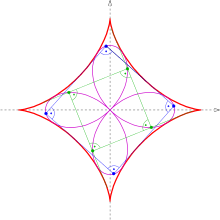
An astroid can be described by the parametric representation
- .
From the condition
one recognizes the distance α in parameter space at which an orthogonal tangent to ċ→(t) appears. It turns out that the distance is independent of parameter t, namely α = ± π/2. The equations of the (orthogonal) tangents at the points c→(t) and c→(t + π/2) are respectively:
Their common point has coordinates:
This is simultaneously a parametric representation of the orthoptic.
Elimination of the parameter t yields the implicit representation
Introducing the new parameter φ = t − 5π/4 one gets
(The proof uses the angle sum and difference identities.) Hence we get the polar representation
of the orthoptic. Hence:
- The orthoptic of an astroid is a quadrifolium.
Isoptic of a parabola, an ellipse and a hyperbola
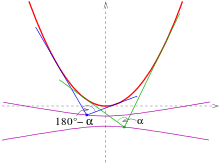
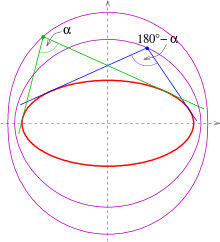
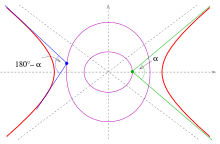
Below the isotopics for angles α ≠ 90° are listed. They are called α-isoptics. For the proofs see below.
Equations of the isoptics
- Parabola:
The α-isoptics of the parabola with equation y = ax2 are the branches of the hyperbola
The branches of the hyperbola provide the isoptics for the two angles α and 180° − α (see picture).
- Ellipse:
The α-isoptics of the ellipse with equation x2/a2 + y2/b2 = 1 are the two parts of the degree-4 curve
(see picture).
- Hyperbola:
The α-isoptics of the hyperbola with the equation x2/a2 − y2/b2 = 1 are the two parts of the degree-4 curve
Proofs
- Parabola:
A parabola y = ax2 can be parametrized by the slope of its tangents m = 2ax:
The tangent with slope m has the equation
The point (x0, y0) is on the tangent if and only if
This means the slopes m1, m2 of the two tangents containing (x0, y0) fulfil the quadratic equation
If the tangents meet at angle α or 180° − α, the equation
must be fulfilled. Solving the quadratic equation for m, and inserting m1, m2 into the last equation, one gets
This is the equation of the hyperbola above. Its branches bear the two isoptics of the parabola for the two angles α and 180° − α.
- Ellipse:
In the case of an ellipse x2/a2 + y2/b2 = 1 one can adopt the idea for the orthoptic for the quadratic equation
Now, as in the case of a parabola, the quadratic equation has to be solved and the two solutions m1, m2 must be inserted into the equation
Rearranging shows that the isoptics are parts of the degree-4 curve:
- Hyperbola:
The solution for the case of a hyperbola can be adopted from the ellipse case by replacing b2 with −b2 (as in the case of the orthoptics, see above).
To visualize the isoptics, see implicit curve.
External links
| Wikimedia Commons has media related to Isoptics. |
Notes
References
- Lawrence, J. Dennis (1972). A catalog of special plane curves. Dover Publications. pp. 58–59. ISBN 0-486-60288-5.
- Odehnal, Boris (2010). "Equioptic Curves of Conic Sections" (PDF). Journal for Geometry and Graphics. 14 (1): 29–43.
- Schaal, Hermann (1977). "Lineare Algebra und Analytische Geometrie". III. Vieweg: 220. ISBN 3-528-03058-5. Cite journal requires
|journal=(help) - Steiner, Jacob (1867). Vorlesungen über synthetische Geometrie. Leipzig: B. G. Teubner. Part 2, p. 186.
- Ternullo, Maurizio (2009). "Two new sets of ellipse related concyclic points". Journal of Geometry. 94: 159–173.